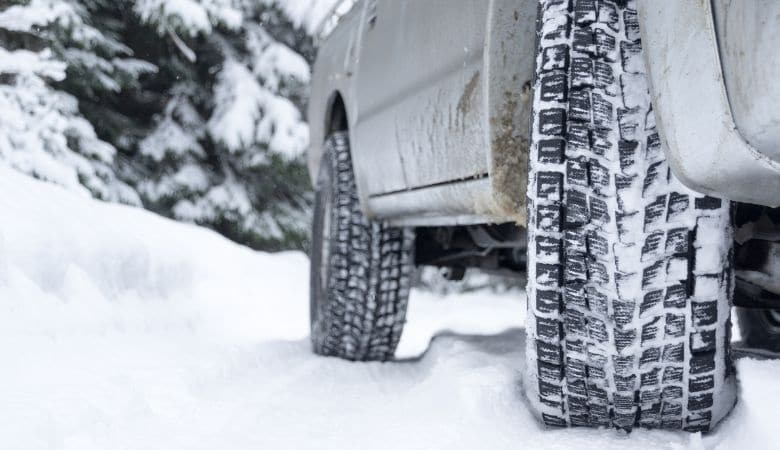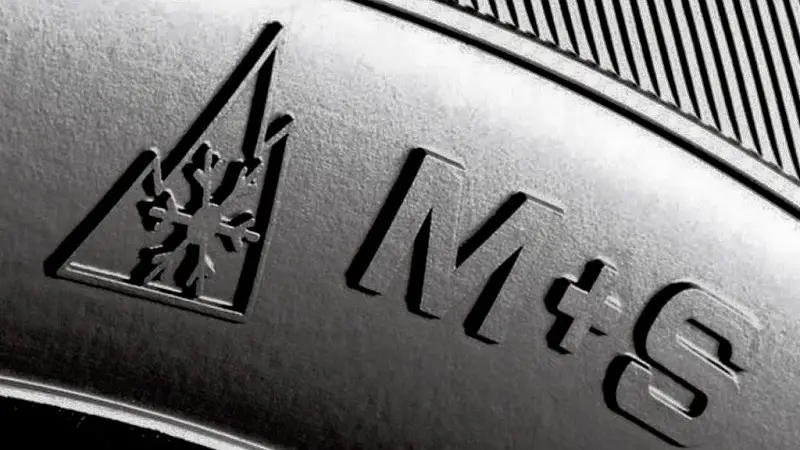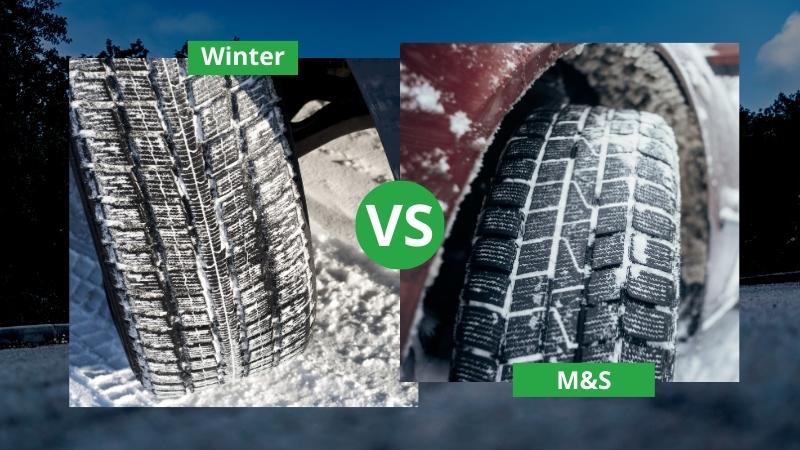When it comes to driving in winter weather, the choice of tires can make a significant difference in your safety and performance on the road.
Two popular options for tackling snowy and icy conditions are winter tires and mud and snow (M+S) tires. It is essential to understand the differences between these tire types, as well as which one is more suitable for your needs.
Winter tires are specifically designed to provide excellent traction on surfaces like snow and ice, thanks to their softer rubber compounds and specialized tread patterns. These tires perform well in temperatures below 45°F (7°C) and are better suited for deeper snow and sub-zero temperatures.
On the other hand, mud and snow tires work well on wet, muddy, or light snowy conditions, but may not offer as much grip in deep snow or extremely low temperatures.
To determine which tire is the right choice for you, consider the winter conditions you typically encounter during your daily drives, and the performance you expect from your tires.
Both types have their pros and cons, and choosing the right one will depend on your specific needs and driving habits.
Winter Tires Explained

Winter tires are specifically designed for driving in cold and snowy conditions. They provide better traction and performance at temperatures below 45°F (7°C), making them an ideal choice for areas with long, cold winters.
Key Features
- Softer rubber compound: Winter tires use a softer rubber compound that remains flexible in cold temperatures, allowing them to grip icy and snowy roads more effectively than other tire types.
- Advanced tread patterns: The innovative tread designs of winter tires help channel slush, snow, and water away from the tire’s contact patch, improving traction and grip.
- Increased siping: Sipes are small slits in the tire’s tread blocks that help increase traction on slippery surfaces. Winter tires usually have more siping than mud and snow tires to enhance grip on icy roads.
Advantages
Choosing winter tires for your vehicle during the colder months can bring several benefits:
- Enhanced traction: The specialized design and materials of winter tires give you more traction and control on cold, snowy, and icy surfaces.
- Safety: Improved road grip means more predictable handling, better braking, and less likelihood of skidding, reducing the risk of accidents and increasing overall road safety.
- Improved performance: In addition to better traction, winter tires can enhance your vehicle’s performance in low temperatures and icy conditions, making your winter driving experience more enjoyable and less stressful.
Disadvantages
While winter tires offer many benefits, there are a few drawbacks to keep in mind:
- Cost: Winter tires can be more expensive than mud and snow tires, and you’ll need to factor in the additional costs of mounting and balancing, as well as storage for your off-season tires.
- Less optimal performance in warmer temperatures: As winter tires are designed specifically for cold and icy conditions, their performance declines when temperatures rise. This makes them unsuitable for year-round use and necessitates a switch to summer or all-season tires when the weather warms up.
Mud And Snow Tires Explained

Mud and snow tires (also known as M+S or M/S tires) are designed to provide improved traction in various adverse weather conditions, such as slush, mud, and light snow.
These tires are a suitable option if you live in an area with moderate winter weather but still require extra traction during the cold months.
Key Features
Mud and snow tires often have deep ridges that offer increased traction on the road in bad conditions. They maintain traction in colder temperatures thanks to rubber that stays flexible in the cold, often meant for traction in temperatures below 45 degrees Fahrenheit.
These tires also have more siping compared to regular all-season tires. Siping refers to the thin slits in the tire tread that improve traction on wet and slippery surfaces. However, they usually have less siping than dedicated winter tires.
Advantages
- Better traction in light snow and slush than regular all-season tires.
- Flexibility in cold temperatures, providing better grip on the road.
- Deeper ridges for improved traction in muddy conditions.
Disadvantages
While mud and snow tires offer several advantages, they still have some drawbacks. They are not specifically designed for heavy snow or extreme cold temperatures like dedicated winter tires. If you frequently drive in heavy snow or temperatures below 45°F, you might be better off with a set of winter tires.
Furthermore, mud and snow tires may not provide the same level of traction on ice as winter tires, which have a softer tread compound designed to grip slippery surfaces better.
Comparing Winter and Mud And Snow Tires
Performance
Winter tires are specifically designed to provide optimum traction in deep snow and sub-zero temperatures. Their softer compound allows the tread to grip better on slippery surfaces like ice or wet pavement, making them perfect for driving on roads with less traction during cold weather months.
Mud and snow (M+S) tires, on the other hand, will perform well in lighter snow but not as effectively in extreme cold or heavy snowfall. They have deeper ridges compared to all-season tires, however, their traction still falls short in comparison to winter tires.
Safety
Driving in winter conditions requires tires that provide maximum grip to ensure your safety. Winter tires are specifically engineered to enhance your vehicle’s handling and braking performance in challenging winter conditions. The soft rubber compound and unique tread designs help maintain traction on ice and snow-covered roads.
While M+S tires can offer improved traction compared to all-season tires, they may not provide the same level of safety and control as dedicated winter tires when faced with deeper snow or extreme cold temperatures.
Cost
Winter tires tend to be a bit more expensive than M+S tires, but investing in the proper tires can ensure you’re getting the best possible performance and safety on the road during harsh winter months. It is essential to balance the initial cost with the benefits these tires provide in terms of safety, traction, and handling.
When deciding between winter and M+S tires, consider the typical weather conditions in your area and the type of driving you do.
If you regularly face deep snow and extremely low temperatures, it’s worth investing in a set of dedicated winter tires, while M+S tires might be a suitable choice for milder winter conditions. Keep in mind that tires should be replaced in sets of four for optimum performance and safety.
Choosing the Right Tire
When deciding between winter and mud & snow tires, it’s essential to consider several factors to make the best choice for your driving needs.
Driving Conditions
The core differentiator between these tire types lies in the driving conditions they cater to. If you mainly drive in colder environments with temperatures below 45°F (7°C) and frequently encounter heavy snow, winter tires are a better option.
These specialized tires provide superior traction and grip on icy and snowy roads. However, if you drive on wet pavement, encounter occasional light snow, and experience a mix of mild winters, mud and snow tires may be more suitable.
Budget
Assess your budget when choosing between winter tires and mud & snow tires. While winter tires offer better performance in colder weather, they might be more expensive than mud & snow tires.
You might also need an additional set of all-season or summer tires for the rest of the year, which can further impact your budget.
Personal Driving Preferences
Your personal driving style and preferences play a role in determining the best tire choice. If you’re cautious and drive at slower speeds during winter, mud and snow tires might suffice.
However, if you drive on highways, require better stopping power, or face slippery ice-covered roads, investing in winter tires is safer and more practical.
In summary, weigh your driving conditions, budget, and preferences to determine the ideal tire for your needs. Remember that your safety should be your top priority when deciding between winter and mud & snow tires.
Conclusion
In understanding the differences between winter tires and mud and snow tires, it’s important to think about your specific driving needs. Winter tires are designed to provide superior traction on icy and snow-covered roads, as well as in sub-zero temperatures, making them ideal for those who regularly face harsh winter conditions.
On the other hand, mud and snow tires perform well in lighter snow and can handle wet and muddy conditions better than winter tires. These tires are a suitable choice if you encounter a mix of winter and mud conditions during your drives.
To make the right decision, consider the climate and road conditions in your area, as well as your driving habits. If you frequently drive in severe winter conditions with deep snow and low temperatures, opting for winter tires is in your best interest.
If you deal with occasional snowfall and muddy roads, then mud and snow tires should suffice for your needs.
Regardless of the choice you make, remember that tire maintenance is crucial for their performance and longevity. Regularly check the tire pressure and tread depth, and stay aware of any signs of wear that could compromise safety on the road.
By choosing the right tire and taking good care of it, you’ll be better prepared to face any driving conditions in safety and comfort.
Hi, my name is Niklas, the head content creator & CEO of Whirling Wheelz. I am very interested in vehicles of all kinds, mainly cars. I have a car mechanics degree from high school and a big hobby of mine is to follow the WRC (World Rally Championship) both online and through travel.

